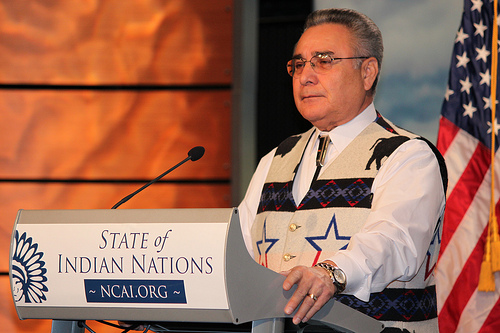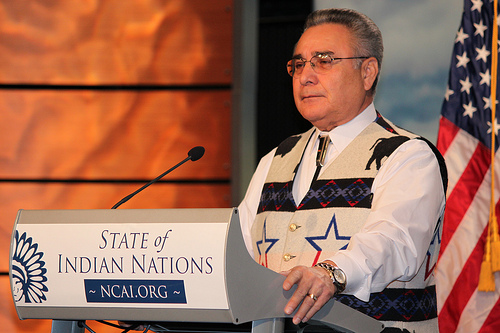 NCAI President Jefferson Keel delivers the 2011 address.Photo: National Congress of American IndiansThis piece was cowritten by Bracken Hendricks and Jorge Madrid of the Center for American Progress.
NCAI President Jefferson Keel delivers the 2011 address.Photo: National Congress of American IndiansThis piece was cowritten by Bracken Hendricks and Jorge Madrid of the Center for American Progress.
President Obama’s second State of the Union address set forward a bipartisan framework aimed at unleashing a clean energy revolution in America. Touching on everything from solar and wind power (hooray!), to nuclear power, to “clean” coal (sigh), the president seemed to leave no stone unturned in his quest for actionable solutions.
But unfortunately, he did omit one major point of potential bipartisan cooperation — one that could greatly accelerate our nation’s transition to a clean energy economy. The Department of Energy estimates that wind power from tribal lands could satisfy 14 percent of total U.S. electricity demand [PDF], and the tribal solar resources could generate 4.5 times the total amount of energy needed to power the entire country.
Remarkably, however, as of today only one commercial-scale renewable energy project operates in all of Indian country. This is because of the incredible amount of federal red tape choking off the green energy opportunities on tribal lands. Many tribes are eager to partner with private sector developers to build large-scale clean energy projects. Such enterprises could be profitable, while respecting tribal values of environmental stewardship. They could also help keep families together by providing good jobs on the reservations.
Unfortunately, many of these sorely-needed investments never come to fruition. A long-standing backlog of catch-22 requirements, crazy-making rules, and outdated laws cause projects to stall in Indian country. Policy barriers slow development and make financing cost-ineffective.
Obama and the GOP should join forces to remove the bureaucratic barriers to rapid renewable energy deployment on Native American lands. Each party has a major incentive to act decisively — and enthusiastically. Democrats love renewable energy and lament Native American poverty. Republicans hate federal bureaucracy and love entrepreneurship. A united effort could boost clean energy; create jobs on reservations; open the door to new investment and entrepreneurial opportunities; reduce federal bureaucracy and; move America closer to energy independence.
The tribes are ready to be full partners in this effort. Last week, the National Congress of American Indians (NCAI) delivered its response to the State of the Union, a report on the State of Indian Affairs. Critical among the strategies proposed by the NCAI is the commitment to pursue greater economic self-sufficiency and reduce crippling tribal unemployment, as well as a “concerted effort to unleash the potential of Indian energy resources throughout the nation.”
The goals put forth by both President Obama and the leaders of the tribal nations are therefore complementary and mutually beneficial. They deserve special consideration as the nation comes together across regions and party lines to take on the next phase of our economic recovery.
In recent weeks, President Obama has boldly called for a 21st-century regulatory system that removes outdated government regulations that would otherwise stifle private sector innovation and slow job growth, making our economy less competitive. Part of this commitment is a government-wide audit of all the rules on the books, and an order to cut where reasonable and necessary. This sentiment is strongly echoed in both chambers of the newly elected 112th Congress, and in both political parties.
Now is the time to apply this logic to Indian country. The administration and policy makers on both sides of the aisle can draw a game plan for reaching multiple goals. By fixing our current policies and offering appropriate incentives, we can streamline government processes, stimulate a new wave of investment in clean energy, and activate the economic potential of tribal lands.
Moreover, these projects have sizable benefits for everyone concerned. Here are a few ideas to start with:
- Promote interagency and federal tribal coordination: Immediate efficiency can be achieved by the White House designating one lead agency to oversee renewable energy projects on tribal lands. Overlapping responsibilities and potential conflicts between the Department of Interior and the Department of Energy, in particular, need to be resolved. Existing processes could then be greatly streamlined and duplicative ones eliminated, mitigating a slow and costly process for development. In addition, agencies should establish a tribal advisory body to ensure meaningful participation of Native American stakeholders in this work.
- Ensure tribal access to the national electricity grid: Tribes must be included in the planning and expansion of our national electricity grid so their project can “plug in” without unfair added expenses. Tribes should be explicitly represented in national, regional,r and state planning processes.
- Enable tribes to develop their energy resources: By providing them access to production and investment tax credits already on the books and available to all other states and local governments. Agencies should also eliminate fees that apply only to projects undertaken on tribal lands. These two relatively easy fixes would go a long way toward jumpstarting a renewable energy renaissance in the Native American community.
- Empower tribes to conduct preliminary clean energy feasibility studies on their lands either internally or through a third party: Presently all preliminary clean energy work, such as land appraisals, needs to be done through the Department of the Interior, creating substantial backlog. Allowing tribes to conduct their own studies either internally or through a third party would expedite this process substantially.
- Provide smart financing incentives for tribal projects: Energy Secretary Steven Chu has already begun championing a process to promote tribal energy development. One idea is to finance the evaluation, development, and deployment of energy efficiency and renewable energy projects on tribal lands through the Tribal Energy Program. These programs should be enhanced to provide valuable start-up funds for projects that will have multiple co-benefits and pay dividends many times over.
Lest we forget, perhaps no part of American society needs new avenues of economic advance more than the Native American population. Many tribal nations lack basic access to jobs, economic opportunity, and even electricity. More than 14 percent of American Indian households in reservations do not have electricity access, and energy on reservations can cost as much as 10 percent above the national average due to a lack of adequate transmission lines. On Indian reservations of the American West, bitter winters force many families to spend up to 70 percent of their total income to heat their homes. Poverty rates on Indian country hover between 27 and 37 percent, and unemployment can reach as high as 48 percent in some tribes.
Clean energy deployment in Indian country can help address many of these woes. Today, the tribes are ready and willing to be key contributors to this nation’s “sputnik moment.” Our economic recovery will depend on how well we utilize our domestic resources and activate the full potential of our human capital — especially those communities that have been hit hardest by the recession. A bipartisan initiative to create “green scissors for the red tape” would clear the way for them to thrive and strengthen their people, and make America as a whole even stronger.
Bracken Hendricks is a senior fellow and Jorge Madrid is a research associate for the Energy Policy Team at the Center for American Progress.




